The gap between what we plan for and what is coming grows wider every quarter, and AI exacerbates it. Organizations that will lead the industry tomorrow are changing how they lead themselves today. They understand that looking ahead is not a side project. It’s the foundation. Futures thinking must move from the margins of innovation teams to the core of leadership practice.

What Is Futures Thinking?
Futures thinking is a strategic approach that enables individuals and organizations to explore and prepare for multiple potential futures. Rather than attempting to predict a single outcome, it encourages considering various scenarios — positive, negative and unexpected — to inform present-day decisions.
The people driving this shift may not call themselves futurists. They may not carry that title. They can be a foresight practitioner, trend analyzer, horizon scanner or a risk analyst. But they can see patterns others miss.
A futurist is someone who helps others see the future more clearly by noticing signals before they become trends, by challenging assumptions that keep teams stuck in outdated models, and by framing decisions through the lens of long-term consequences. They stretch time. They widen perspective. They surface the forces already shaping tomorrow and ask, “What will this mean for us, and what are we willing to do about it today?”
Futures Thinking in Action
The book CEO Excellence makes clear that the world’s best-performing CEOs share a single orientation. They think further out. They make decisions based on where the world is going, not just where it stands. They look past noise and chase signals. They run companies through the lens of change. These leaders are strategic, but they are also futurists in practice. And they succeed because of it.
One clear example is Nvidia’s CEO, Jensen Huang. Huang foresaw the transformative potential of artificial intelligence long before it became mainstream. Recognizing that AI would require powerful processing capabilities far beyond traditional computing, he strategically pivoted Nvidia from being primarily a graphics chip manufacturer into a leader in AI hardware and software. By anticipating the trajectory of technological advancement, Huang positioned Nvidia to become an indispensable player in the AI revolution, resulting in the company's extraordinary success today.
In The Emergent Approach to Strategy, Peter Compo reframes strategy as continuous motion rather than a fixed map, evolving dynamically as conditions change. Goals and constraints matter, yet the pathway adapts to new inputs, making foresight essential because forecasts cannot hold unless they bend. Compo blends strategic foresight (i.e., futurism) directly into his innovative strategy framework by using scenario planning to anticipate multiple plausible futures.
For instance, an organization might explore scenarios such as economic downturns, technological breakthroughs or regulatory shifts, allowing it to remain resilient amid disruption. Successful strategies sense change before arrival and draw insights from policy, markets, culture and ecology, embedding the ability to navigate uncertainty into the core of leadership.
Good Strategy Looks Forward
If you don’t envision the future, then you will be left in the past.
Nowhere is this more urgent than in product development.
The best product leaders design things for people who do not yet exist. They build for behaviors still forming. They serve needs that have not yet reached scale. Product roadmaps anchored in present-state personas will always trail the curve. The future user is already on the move. Their values are shifting. Their habits are changing. Their environments are transforming.
Futures thinking gives product teams a way forward. It offers tools to explore what comes next. Future personas. Speculative scenarios. Artifacts from possible worlds. These activities are not thought exercises. They are strategy tools. They help teams see how their choices shape what becomes normal. They reveal risk. They surface opportunity. They allow teams to lead rather than follow.
The organizations that move first are those that see early. And those who see early are those who build foresight into every layer of their culture. For example, the Digital Equipment Corporation ignored early signals about personal computing from fringe innovators like Atari and Commodore, missing a major technological shift that ultimately led to its collapse.
You don’t need a Chief Futurist. The title sounds impressive, but it often signals gatekeeping. Some treat foresight like a closed circle — guarding tools, cloaking methods and turning it into a status game. It’s more about insecurity than impact. Real foresight scales when it’s shared. It belongs across the organization, not behind one title.
For example, Salesforce fosters foresight by regularly conducting scenario workshops across diverse teams that align with their three-part model: anticipate change, imagine scenarios and shape choices. The method allows employees to build scenarios and pressure test decisions, empowering employees at all levels to anticipate future market shifts and integrate insights directly into their strategic planning processes. This type of leadership sparks widespread adoption of foresight practices rather than keeping the responsibility confined to one person’s vision or authority.
How to Practice Futures Thinking in Your Strategy
Here’s how any team can start embedding futures thinking into day-to-day strategy and decision-making:
Run Cross-Functional Scenario Workshops Quarterly
Pair product, operations, marketing, finance and compliance leaders to explore future scenarios (e.g., AI regulation shifts, new consumer behaviors, geopolitical instability). Assign each group a “plausible future” and have them build a response plan.
Appoint Foresight Facilitators, Not Owners
Instead of a Chief Futurist, empower a rotating group of team leads to collect weak signals, run horizon scanning exercises, and bring trends into planning conversations.
Create ‘Future Artifacts’ During Planning Cycles
Ask teams to create speculative product mockups, press releases from the future or customer persona snapshots from five years out. These artifacts help visualize what success could look like in multiple futures.
Integrate Signal Spotting Into Everyday Workflow
Set up shared Slack or Teams channels where people can drop articles, tech launches, or cultural shifts they’re noticing. Tag them by domain (tech, consumer, policy, ecology) and review monthly.
Use Foresight as a Lens in Strategic Decisions
When evaluating a roadmap, hiring strategy, or investment, ask, “What assumptions are we making about the future — and what if they’re wrong?” This reframes certainty as risk and uncertainty as opportunity.
Rehearse Disruption, Not Just Continuity
Include “What If” questions in leadership reviews, e.g., What if our largest customer changes business models? What if our category disappears? These unlock readiness without fear-based planning.
When people only see one future, usually an extrapolation of the present, they tend to default to passive planning, waiting for change to force their hand. Futures thinking breaks that spell. It shows that multiple futures are always in play, and that actions taken today can shape which of them becomes reality. That awareness changes behavior.
This kind of leadership is rare. But it is rising. The next wave of transformation will not come from trend reports. It will come from within. It will come from teams that ask better questions. That learn from the future before it arrives. That understanding foresight is not a prediction. It is preparation. And preparation is power.
Embrace Futures Thinking
To unlock that power, organizations must invite futurists into the center of the conversation. Bring their methods into your planning cycles. Give their insights weight in strategic debates. Most of all, build the capacity across your teams. Because the goal is not to rely on one person with a future-facing title. The goal is to build an organization that can think ten years ahead, act three years ahead and execute today.
The future belongs to those who prepare for it. Give the people doing that work a seat. Then, make sure they are not the only ones in the room thinking that way.





